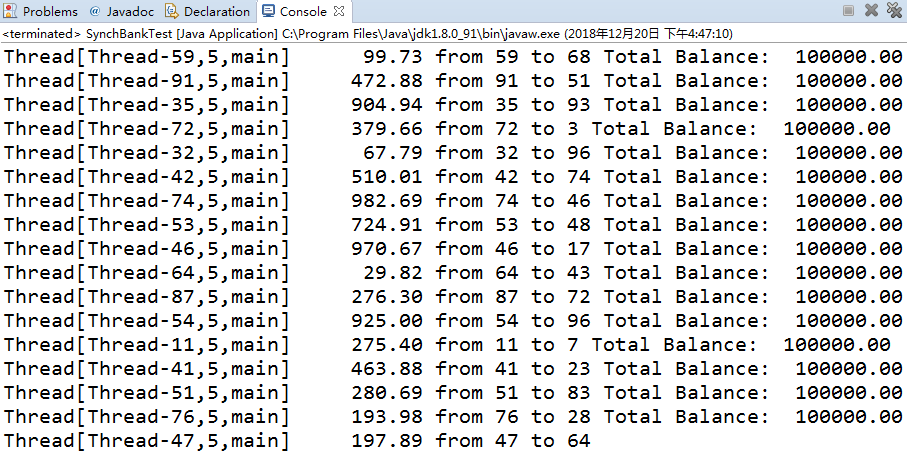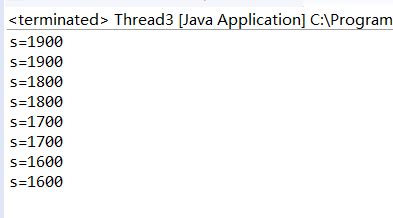刘志梅201771010115.《面向对象程序设计(java)》第十七周学习总结
实验十七 线程同步控制
实验时间 2018-12-10
1、实验理论知识
多线程
多线程是进程执行过程中产生的多条执行线索。
进程
线程是比进程执行更小的单位。线程不能独立存在,必须存在于进程中,同一进程的各线程间共享进程空间的数据。每个线程有它自身的产生、存在和消亡的过程, 是一个动态的概念。线程创建、销毁和切换的负荷远小于进程,又称 为轻量级进程(lightweight process)。
Java实现多线程
-创建Thread类的子类
-在程序中定义实现Runnable接口的类
用Thread类的子类创建线程
首先需从Thread类派生出一个子类,在该子类中 重写run()方法。
class hand extends Thread { public void run() {……} }
然后用创建该子类的对象
Lefthand left=new Lefthand();
Righthand right=new Righthand();
最后用start()方法启动线程
left.start();
right.start();
用Runnable()接口实现线程
首先设计一个实现Runnable接口的类;
然后在类中根据需要重写run方法;
再创建该类对象,以此对象为参数建立Thread 类的对象;
调用Thread类对象的start方法启动线程,将 CPU执行权转交到run方法。
线程的终止:调用interrupt()方法。
多线程并发运行不确定性问题解决方案:引入线 程同步机制,使得另一线程要使用该方法,就只 能等待。
在Java中解决多线程同步问题的方法有两种: - Java SE 5.0中引入ReentrantLock类。 - 在共享内存的类方法前加synchronized修饰符。
2、实验内容和步骤
实验1:测试程序并进行代码注释。
测试程序1:
l 在Elipse环境下调试教材651页程序14-7,结合程序运行结果理解程序;
l 掌握利用锁对象和条件对象实现的多线程同步技术。
import java.util.*; import java.util.concurrent.locks.*; /** * A bank with a number of bank accounts that uses locks for serializing access. * @version 1.30 2004-08-01 * @author Cay Horstmann */ public class Bank//Bank类 { private final double[] accounts;//银行运转的基础数据 private Lock bankLock; private Condition sufficientFunds; /** * Constructs the bank. * @param n the number of accounts * @param initialBalance the initial balance for each account */ public Bank(int n, double initialBalance) { accounts = new double[n]; Arrays.fill(accounts, initialBalance);//调用initialBalance生成锁对象属性 bankLock = new ReentrantLock(); sufficientFunds = bankLock.newCondition(); } /** * Transfers money from one account to another. * @param from the account to transfer from * @param to the account to transfer to * @param amount the amount to transfer */ public void transfer(int from, int to, double amount) throws InterruptedException { bankLock.lock(); //临界区加锁 try { while (accounts[from] < amount) sufficientFunds.await();//用锁对象生成条件对象sufficientFunds System.out.print(Thread.currentThread()); accounts[from] -= amount; System.out.printf(" %10.2f from %d to %d", amount, from, to); accounts[to] += amount; System.out.printf(" Total Balance: %10.2f%n", getTotalBalance()); sufficientFunds.signalAll(); } finally { bankLock.unlock(); } } /** * Gets the sum of all account balances. * @return the total balance */ public double getTotalBalance() { bankLock.lock(); try { double sum = 0; for (double a : accounts) sum += a; return sum; } finally { bankLock.unlock(); } } /** * Gets the number of accounts in the bank. * @return the number of accounts */ public int size() { return accounts.length; } }
/** * This program shows how multiple threads can safely access a data structure. * @version 1.31 2015-06-21 * @author Cay Horstmann */ public class SynchBankTest { public static final int NACCOUNTS = 100; public static final double INITIAL_BALANCE = 1000; public static final double MAX_AMOUNT = 1000; public static final int DELAY = 10; public static void main(String[] args) { Bank bank = new Bank(NACCOUNTS, INITIAL_BALANCE); for (int i = 0; i < NACCOUNTS; i++) { int fromAccount = i; Runnable r = () -> { try { while (true) { int toAccount = (int) (bank.size() * Math.random()); double amount = MAX_AMOUNT * Math.random(); bank.transfer(fromAccount, toAccount, amount); Thread.sleep((int) (DELAY * Math.random())); } } catch (InterruptedException e) { } }; Thread t = new Thread(r); t.start(); } } }

测试程序2:
l 在Elipse环境下调试教材655页程序14-8,结合程序运行结果理解程序;
l 掌握synchronized在多线程同步中的应用。
/** * This program shows how multiple threads can safely access a data structure, * using synchronized methods. * @version 1.31 2015-06-21 * @author Cay Horstmann */ public class SynchBankTest2 { public static final int NACCOUNTS = 100; public static final double INITIAL_BALANCE = 1000; public static final double MAX_AMOUNT = 1000; public static final int DELAY = 10; public static void main(String[] args) { Bank bank = new Bank(NACCOUNTS, INITIAL_BALANCE);//创建一个银行对象 for (int i = 0; i < NACCOUNTS; i++) { int fromAccount = i; Runnable r = () -> { try { while (true) { int toAccount = (int) (bank.size() * Math.random());//拿出一个随机账户 double amount = MAX_AMOUNT * Math.random();//设定随机一笔钱 bank.transfer(fromAccount, toAccount, amount);//转账操作 Thread.sleep((int) (DELAY * Math.random()));//随机休眠时间 } } catch (InterruptedException e) { } }; Thread t = new Thread(r);//创建一个线程 t.start();//线程处于可运行状态 } } }
import java.util.*; /** * A bank with a number of bank accounts that uses synchronization primitives. * @version 1.30 2004-08-01 * @author Cay Horstmann */ public class Bank { private final double[] accounts; /** * Constructs the bank. * @param n the number of accounts * @param initialBalance the initial balance for each account */ public Bank(int n, double initialBalance) { accounts = new double[n]; Arrays.fill(accounts, initialBalance); } /** * Transfers money from one account to another. * @param from the account to transfer from * @param to the account to transfer to * @param amount the amount to transfer */ public synchronized void transfer(int from, int to, double amount) throws InterruptedException { while (accounts[from] < amount) wait();//使线程处于等待集中 System.out.print(Thread.currentThread()); accounts[from] -= amount; System.out.printf(" %10.2f from %d to %d", amount, from, to); accounts[to] += amount; System.out.printf(" Total Balance: %10.2f%n", getTotalBalance()); notifyAll();//唤醒所有等待的线程 } /** * Gets the sum of all account balances. * @return the total balance */ public synchronized double getTotalBalance() { double sum = 0; for (double a : accounts) sum += a; return sum; } /** * Gets the number of accounts in the bank. * @return the number of accounts */ public int size() { return accounts.length; } }

测试程序3:
l 在Elipse环境下运行以下程序,结合程序运行结果分析程序存在问题;
l 尝试解决程序中存在问题。
|
class Cbank { private static int s=2000; public static void sub(int m) { int temp=s; temp=temp-m; try { Thread.sleep((int)(1000*Math.random())); } catch (InterruptedException e) { } s=temp; System.out.println("s="+s); } }
class Customer extends Thread { public void run() { for( int i=1; i<=4; i++) Cbank.sub(100); } } public class Thread3 { public static void main(String args[]) { Customer customer1 = new Customer(); Customer customer2 = new Customer(); customer1.start(); customer2.start(); } } |
class Cbank { private static int s=2000;//当类加载时s赋值为2000 public static void sub(int m) { int temp=s; temp=temp-m; try { Thread.sleep((int)(1000*Math.random())); } catch (InterruptedException e) { }//捕获中断异常 s=temp; System.out.println("s="+s); } } class Customer extends Thread//继承 { public void run()//中值返回 { for( int i=1; i<=4; i++) Cbank.sub(100); } }
public class Thread3 { public static void main(String args[]) { Customer customer1 = new Customer();//把变量customer1的值设置为分配给新的Customer对象的内部地址 Customer customer2 = new Customer(); customer1.start(); customer2.start(); } }

修改后的代码:
class Cbank { private static int s=2000; public synchronized static void sub(int m) { int temp=s; temp=temp-m; try { Thread.sleep((int)(1000*Math.random())); } catch (InterruptedException e) { } s=temp; System.out.println("s="+s); } } class Customer extends Thread { public void run() { for( int i=1; i<=4; i++) Cbank.sub(100); } } public class Thread3 { public static void main(String args[]) { Customer customer1 = new Customer(); Customer customer2 = new Customer(); customer1.start(); customer2.start(); } }

实验2 编程练习
利用多线程及同步方法,编写一个程序模拟火车票售票系统,共3个窗口,卖10张票,程序输出结果类似(程序输出不唯一,可以是其他类似结果)。
Thread-0窗口售:第1张票
Thread-0窗口售:第2张票
Thread-1窗口售:第3张票
Thread-2窗口售:第4张票
Thread-2窗口售:第5张票
Thread-1窗口售:第6张票
Thread-0窗口售:第7张票
Thread-2窗口售:第8张票
Thread-1窗口售:第9张票
Thread-0窗口售:第10张票
package tracket; public class tracket { public static void main(String[] args) { Mythread mythread = new Mythread(); Thread t1 = new Thread(mythread);//实例化了一个Thread对象thread1 Thread t2 = new Thread(mythread); Thread t3 = new Thread(mythread); t1.start();//线程启动 t2.start(); t3.start(); } } class Mythread implements Runnable { int t = 1; boolean flag = true; @Override public void run() { // TODO Auto-generated method stub while (flag) { try { Thread.sleep(500);//休眠时间500毫秒 } catch (Exception e) { // TODO: handle exception e.printStackTrace(); } synchronized (this) { if (t <= 10) { System.out.println(Thread.currentThread().getName() + "窗口售:第" + t + "张票"); t++; } if (t > 10) { flag = false; } } } } }

实验总结:本周实验学习了线程的同步,对线程有了更能进一步的学习,最后的编程的练习题通过学长的讲解以及演示,代码语句的解释,深入了解线程同步问题;本周也是最后一周的实验,这学期通过老师和学长的教学学习到了不少java的知识,非常感谢。


